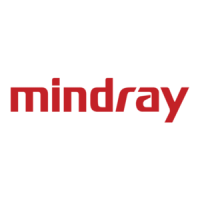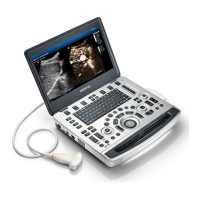6 Image Acquisition
Operator’s Manual 6 - 31
2. Tap [RIMT] to activate the function. Use [Side] to select left or right carotid.
3. Use the trackball to locate ROI over the target area. The dotted line of the ROI is in the middle
of the blood vessel. Press <Set> to confirm the position and size of the ROI.
4. Tap [Start Calc] to measure RIMT of left carotid and right carotid. 6 RIMT values (each RIMT
value represents maximum IMT value within one cardiac cycle), RIMT average value
(arithmetic mean value of the 6 RIMT values), SD (standard deviation of the 6 RIMT values)
and ROI length are displayed in the result pane.
5. Tap [Accept Result] or press <Set>, the image is frozen. You may save single frame image and
results to the result pane.
Tap [Cancel Result] to recalculate RIMT. Perform step 4 to reset the RIMT.
6. Tap [Report] to view the report. Only last acceptable data, including RIMT on left and right
carotid, is in the data sheet.
You can perform:
– Deleting data: select RIMT data from the data sheet. Tap [Delete Rows] to remove the
RIMT data of the left and the right carotid.
– Viewing graphic: tap [Trend] to view the RIMT graphic. The data on the graphic is same
with these in data list. The RIMT average value, SD and ROI length of the exams are
displayed at the bottom of the graphic (including the current exam).
– Previewing the report: tap [Preview] to show IMT. The RIMT average value, SD and ROI
length of the exams are displayed.
For details about report operation, refer to "Advanced Volume".
7. Tap [RIMT] again to exit.
6.14 Tissue Tracking Quantitative Analysis
Tissue Tracking Quantitative Analysis images are provided for reference only,
not for confirming diagnoses.
Apart from TDI imaging function, the system also provides tissue tracking QA function for
myocardial movement evaluation.
By tissue tracking QA function, the ultrasound system will scan each pixel position by frame within
the cardiac cycle, and then use region matching method and auto-correlation searching method to
trace each spot and calculate the movement, so as to determine myocardial motion in a more
quantitative way.
Only use the probes that support stress echo function under the cardiac mode to start Tissue
Tracking QA function.
6.14.1 Basic Procedures for Tissue Tracking QA
Perform the following procedure:
1. Open a saved B mode cardiac cine file.
A cin. format file which contains more than 1 cardiac cycle (with 2 R waves) and ECG signal.

